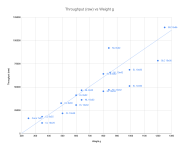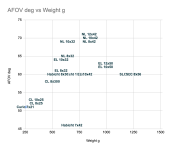kimmik
Well-known member

7x and 8x chart. Binos towards the top left have better global brightness for weight, FL 7x42 and HG 8x42 are the best.
Binos towards the bottom right have worse global brightness for weight, but possibly better contrast depending on how it was optimised. e.g. all Leicas.
Center brightness is just transmission and exit pupil size - no need to use this chart for that.
One thing I've noticed already, is that SF 42 and SFL 40 are equally "top left", SF 32 and VP are equally midway, and Conquests are equally "bottom right", a clue to the Zeiss design and pricing strategy.
Graph deleted.
Binos towards the bottom right have worse global brightness for weight, but possibly better contrast depending on how it was optimised. e.g. all Leicas.
Center brightness is just transmission and exit pupil size - no need to use this chart for that.
One thing I've noticed already, is that SF 42 and SFL 40 are equally "top left", SF 32 and VP are equally midway, and Conquests are equally "bottom right", a clue to the Zeiss design and pricing strategy.
Graph deleted.
Last edited:







